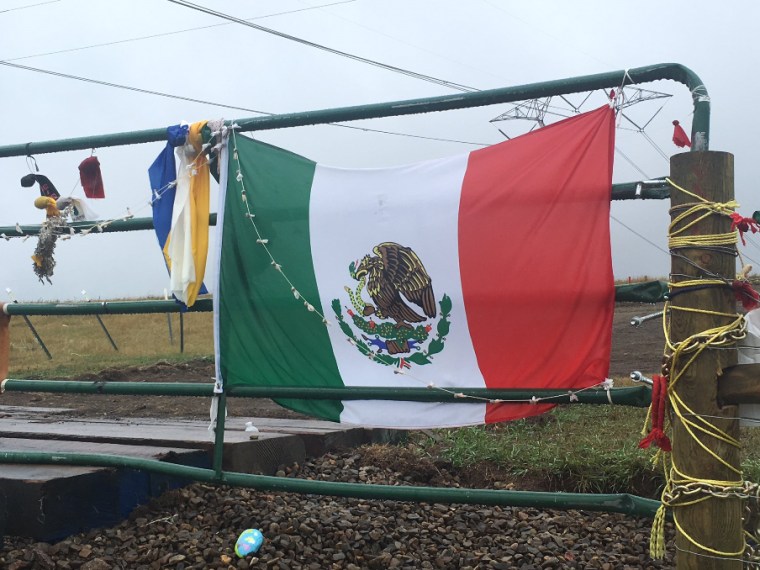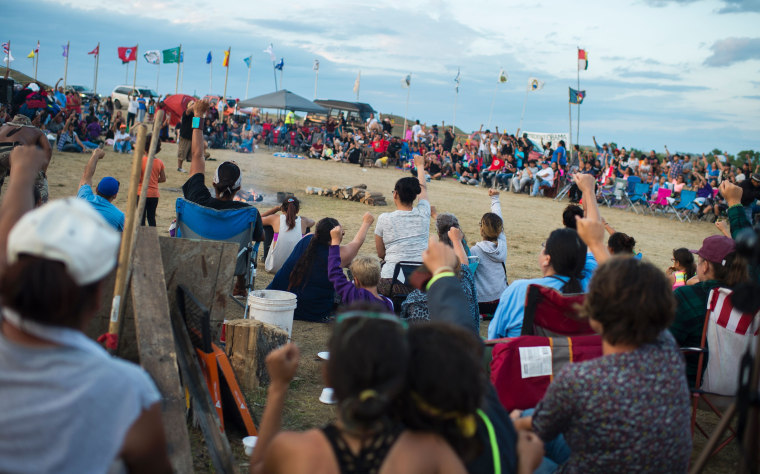STANDING ROCK, N.D. — The national flag of Mexico tells a story. The eagle perched atop a cactus and holding a snake is a founding myth of the Aztec, a sacred sign from the sun god marking the spot where the wandering tribe was to build their city. Legend says the sign appeared in Lake Texcoco, on a small island that became the city of Tenochtitlan, the site of modern day Mexico City.
On a drizzly September afternoon in North Dakota, the flag tells another story. It is draped across a rusty gate, the entrance to a construction site where activists have been arrested for protesting the Dakota Access Pipeline.

Mounds of earth and a few parked bulldozers flank a deep gash in the ground where the pipeline snakes through the land. It comes to a sudden halt here, near Cannonball, North Dakota, just north of the Standing Rock Sioux Reservation and a few miles out from Red Warrior Camp and Sacred Stone Camp, the hubs of resistance for indigenous people and allies who have rallied to stop the project.
They say the pipeline, which has already torn through sacred burial sites, threatens Native American sovereignty. They also say it will contaminate the drinking water the Tribe desperately needs to live, as the pipeline’s planned trajectory runs under a lake near the reservation.
“Water is life,” say the protesters in their chants and on their signs.
Energy Transfer Partners, the company overseeing the pipeline, meanwhile, argues it will create up 12,000 construction jobs and that it is a better environmental alternative to transporting oil via trucks and trains, which have a history of explosions.
RELATED: Dakota Access Pipeline: Unions Call On Obama to 'Stand Up for American Workers'
But the argument turned violent when guards threatened protesters with dogs. Some were pepper sprayed, many were arrested, and eventually, the National Guard was called in.
It’s a modern extension of a conflict that began when Europeans first arrived in the Americas. It’s no wonder, then, that many Natives see Standing Rock as a lightning rod, a rallying cry to unite in the struggle for stewardship over the land, a pervasive issue across tribes and indigenous communities the world over.
RELATED: Oil Pipeline Protest Turns Violent in North Dakota
The Mexican flag stands apart from most of the other flags draped on the gate; it is one of the few representing a country that is not a sovereign tribal nation. But many allies from the south have made the long journey to North Dakota, including indigenous communities in Mexico.
“The Aztec are here,” said a man filming the arrival of yet another tribe to Red Warrior Camp. The campsite has grown into its own ecosystem, a small town of teepees and tents complete with kitchens, schools and a center for legal advice for those who’ve been arrested or who plan to be.
They arrived to the sound of drums. The danzantes, in their colorful, ornate headdresses, were the first to emerge from the dark, dancing their way down the trail of flags that leads to the heart of camp. It is custom, when new tribes arrive, to make an appearance at the clearing where they can announce themselves and be welcomed.
And one by one, the tribes from Latin America arrived and announced themselves. They brought their strength in numbers and t knowledge — many had taken on large oil companies, and some had even won.
“The world needs us right now,” said Nina Gualinga, an activist from the Sarayaku Tribe in the Ecuadorian Amazon, shortly after the arrival of her tribe. The Sarayaku has been successfully fending off the government from selling the drilling rights to their land. “The statistics say we are 4 percent of the population, but we are protecting more than 80 percent of the world’s biodiversity.”
And one by one, the tribes from Latin America arrived and announced themselves.
For many Natives at camp, the presence of tribes from the south held spiritual significance.
“Did you hear about the prophecy?” Kechina Nelson asked as we picked our way through a forest of tents. Kechina, from the Lakota Sioux Tribe, had been guiding me through camp since I arrived. We walked on wood pallets that had been laid down as bridges over the mud while her mother and her boyfriend worked on building a fire in their tent.
“The elders said that when the eagle of the north and the condor of the south fly together, the earth will awaken,” she said. We paused at the camp clearing to observe a prayer ceremony before lunch. An elder blessed the food and offered the spirits the first plate. We would all be sharing the leftovers.
“I don’t know,” she continued when the prayer was done. “I get goose bumps every time I hear it.”
Another awakening of sorts is occurring among Latinos. More and more are starting to recognize their indigenous ancestry.
The phenomenon is rooted in resistance to the 1994 North American Free Trade Agreement, when the government of Mexico felt incentivized to strip indigenous landowners of protection from privatization, the goal being to attract foreign investors.
Approximately 90 percent of the population of Mexico is Amerindian or Mestizo, a mix of indigenous ancestry with the European. For most Mexicans, it has long been taboo to identify with the indigenous. A search for identity in the wake of foreign intervention, however, is inspiring many to reassess themselves.
In the United States, Latino communities and Native communities struggle with many of the same systemic issues, such as environmental justice. Both communities tend to live on land in close proximity to environmentally hazardous practices that threaten the water supply.
RELATED: Fracking or Drinking Water? That May Become the Choice
The shared values of Native Americans and Latinos are also reflected in how much they care about the environment. According to a study by Plos One, Latinos rank the environment as a major issue alongside immigration, with 76 percent of Latinos saying they agree that the earth is heating up. That is 14 percent higher than Whites in the U.S.
This much is clear: resistance to corporate greed is awakening something ancient in both Native and Latino communities, and bringing them together in new ways. Nowhere is this more apparent than in Standing Rock.
The protest against the Dakota Access Pipeline has been intertwined with indigenous spirituality from the start. But it has since evolved into something bigger than a protest. It’s become a burgeoning epicenter of sacred knowledge, a place where indigenous people can come together and share their histories with one another.
It’s an exchange that goes beyond borders, extending into the south and resonating with indigenous communities who can easily see themselves in their northern neighbors and in the battles they’re fighting.
Concurrent with this is a shift in Latino consciousness. It draws from the collective memory of the indigenous to form a new identity in response to globalization. It is rooted in resistance, and takes environmental justice as one of its cornerstones. This shift, like the protest at Standing Rock, looks to the past for answers to the problems of the present.
RELATED: Latino Heritage and Indigenous Yawanawá Tribe Cross Paths in Miami
Everywhere in Red Warrior Camp there are smiles. There are songs. On a typical afternoon, the sound of drums provides the beating heart of the fledgling village that grows bigger by the day. Here, it’s not uncommon to see a group of individuals, all from different parts of the world and with different relationships to their indigeneity, sitting in a tent together and delighting in discovering the ways their people are both alike and different.
The teepees and the daily ceremonies harken back to tradition, but the camp stands as a blueprint for the future of resistance to threats against the land.
In this regard, Red Warrior Camp isn’t just a call to recover what’s been lost. It’s a sign to build something new.

